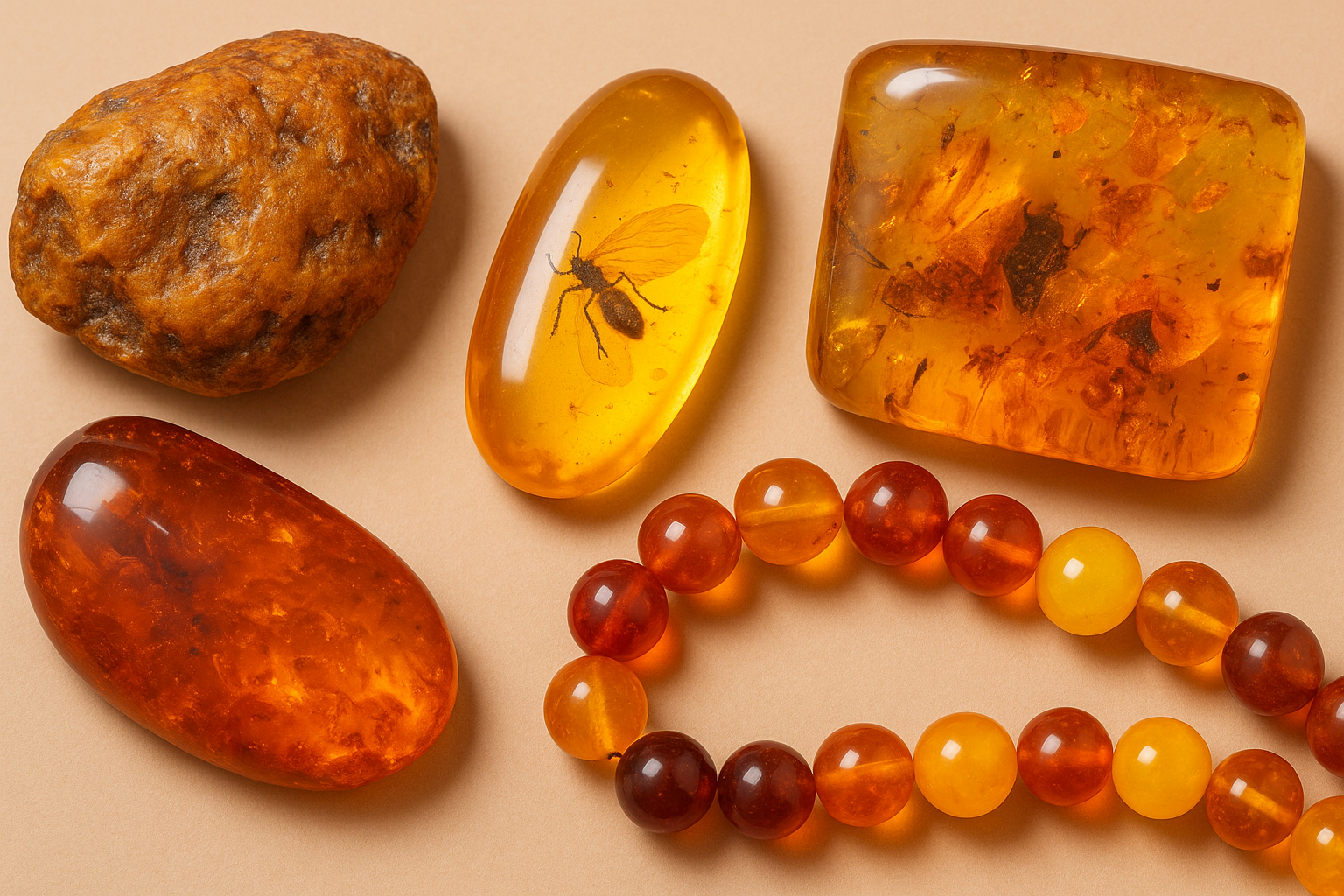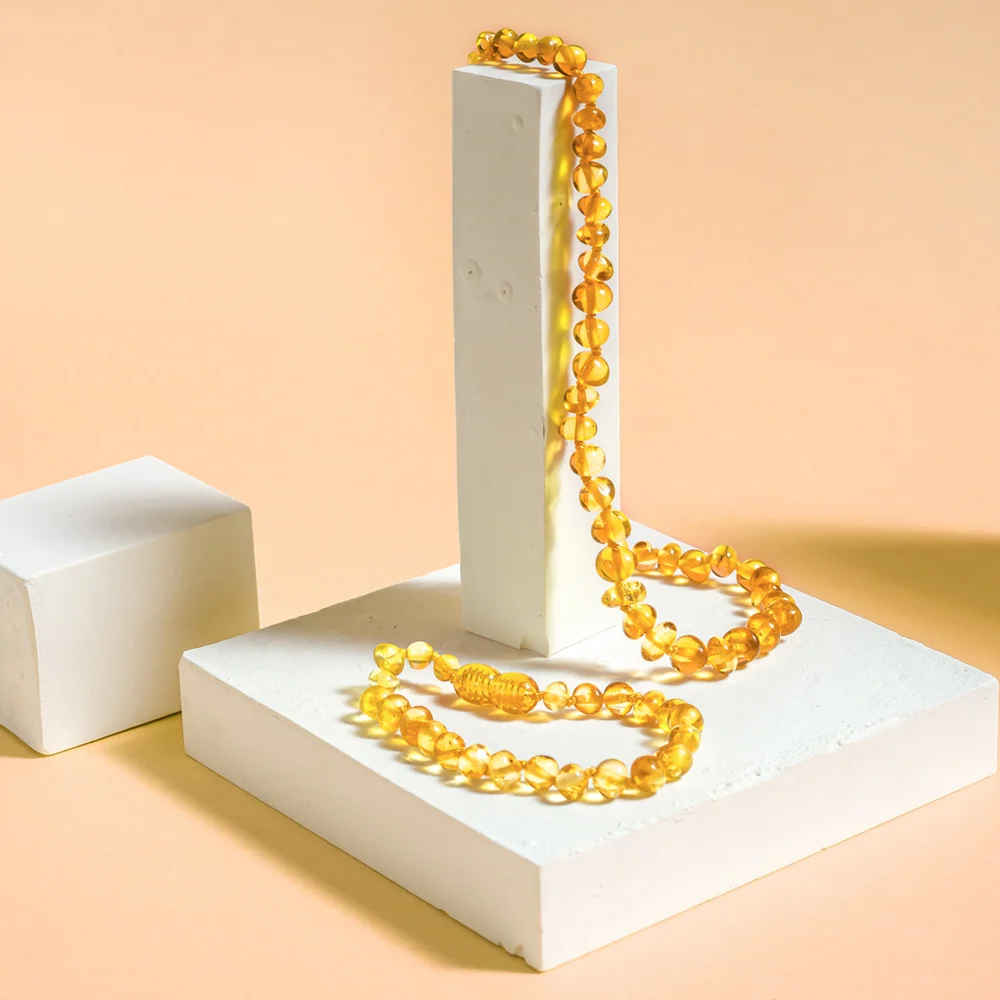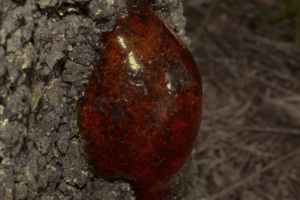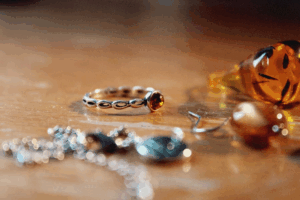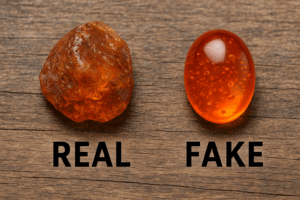Amber – a gemstone born from ancient forests and the passage of millennia, glowing with the warmth of the sun and stories of the past. In this blog post, we’ll explore the mesmerizing colors of amber, discover what they symbolize, and learn how to tell real amber from clever imitations. Join us as we journey through the radiant world of Baltic amber, uncovering its timeless beauty and natural wonder.
What Color is Amber?
Amber is a captivating, organic gemstone that has fascinated people for thousands of years, enchanting civilizations with its radiant glow and unique inclusions. While most people think of amber as a rich, warm golden-yellow—evoking images of sun-drenched beaches or flickering candlelight—the reality is far more diverse and vibrant. In fact, amber’s palette is a stunning kaleidoscope of natural hues, a testament to the myriad factors that influence its color during the slow, transformative journey from sticky tree resin to fossilized gemstone.
Amber forms when ancient trees exude resin to protect themselves from injury or disease. Over millions of years, this resin hardens and undergoes a complex process of polymerization and oxidation, becoming the lustrous gemstone we treasure today. But it’s not just time that sculpts amber’s color—the environment plays an equally crucial role. Elements like iron, sulfur, and the presence of organic inclusions (like plant matter, insects, or even air bubbles) create a symphony of color variations. In some cases, exposure to heat or pressure deep within the earth can intensify these colors or create completely new shades, making each piece of amber a small, natural masterpiece.
The result? A gemstone that can range from creamy white to deep cherry red, from earthy brown to luminous green, and even to the rarest and most ethereal—shimmering blue amber. Each hue seems to hold a story of its own, whispering of ancient forests, long-lost creatures, and the quiet alchemy of time. This incredible range of colors is not just a quirk of nature—it’s a testament to the geological and biological wonders of the Baltic Sea region, where some of the world’s finest amber deposits are found. From the windswept shores of Lithuania to the rugged cliffs of Poland and Russia, these ancient lands have been the cradle of amber’s luminous beauty for countless generations.
In this article, we’ll take a closer look at these mesmerizing hues and explore their meanings and allure. We’ll discover how each shade of amber reveals a unique chapter in the stone’s history and learn why these captivating colors continue to inspire fascination in cultures around the world. So join us as we journey through the vibrant world of Baltic amber—where every stone is a window to the past and a testament to nature’s timeless artistry.
What Do the Colors of Amber Look Like?
Amber’s palette is as broad as it is beautiful. Let’s explore the most common and rare varieties, one by one.
White Amber
White amber, also known as “bone amber,” is one of the rarest types. Its soft, milky appearance often includes delicate swirling patterns that create a dreamy, opalescent effect. This variety has a distinctly creamy hue, sometimes almost resembling ivory. White amber is usually formed when tiny air bubbles or fine mineral inclusions become trapped in the resin, giving it a soft, cloud-like quality.
Yellow – Honey or Orange Amber
When people picture amber, they’re often thinking of this classic color. Ranging from golden yellow to warm orange, honey or orange amber is the most common and widely recognized. It’s beloved for its warmth and radiant glow, reminiscent of a golden sunset or a flickering candle flame. This shade owes its color to the presence of microscopic plant and organic matter that was trapped within the resin millions of years ago.
Cherry Amber
Cherry amber is a deep, rich red color, sometimes bordering on burgundy. This striking shade is created through a natural aging process or through heating and oxidation. Cherry amber has an air of luxury and sophistication, making it a popular choice for statement jewelry. Its deep tones catch the light beautifully and highlight the gemstone’s natural inclusions.
Brown Amber
Brown amber is earthy and grounding, with hues ranging from light caramel to deep, almost chocolatey brown. This variety often exudes a rustic charm and can contain fascinating organic inclusions, like bits of ancient plant material or insects. Brown amber feels warm and natural, connecting the wearer to the rich, ancient forests where it was born.
Green Amber
Green amber is an enchanting, almost mystical color. It forms when the resin’s natural elements interact with minerals in the soil over time, resulting in a greenish tint. While natural green amber is relatively rare, some pieces are enhanced to bring out this vivid color. Genuine green amber tends to have an earthy, olive tone, and it’s highly prized for its distinctive and unusual look.
Blue Amber
The rarest and most sought-after variety, blue amber, is a true wonder. Under natural light, blue amber may appear brownish, but when illuminated by UV light or strong sunlight, it reveals an ethereal blue glow. This phenomenon is caused by the fluorescence of certain hydrocarbons within the amber. Blue amber is primarily found in the Dominican Republic, but rare examples can be found in the Baltic region.
Black Amber
Black amber, also known as “jet amber,” is typically a very dark brown or black color. Though it appears opaque at first glance, black amber can sometimes reveal a deep, reddish glow when held up to bright light. This variety forms when the resin becomes heavily saturated with organic matter, giving it its dark, inky appearance. It has a dramatic, almost mysterious allure.
Cognac Amber
Cognac amber is a warm, rich brownish-orange that resembles the color of fine brandy. It’s prized for its depth and brilliance. Like a glass of aged cognac, this amber color has a luxurious, timeless quality. Cognac amber is often used in high-end jewelry, appreciated for its sophisticated, classic look.
More Colors
Besides these primary colors, amber can exhibit subtle variations such as lemon yellow, golden brown, and even a reddish-orange called “sunset amber.” Each piece of amber has its own unique pattern, formed over millions of years, making every stone a one-of-a-kind work of art.
Most Common Color in the Baltic Sea
Among all these stunning hues, the most common color of Baltic amber is a warm honey-yellow to deep golden-orange. This classic shade has captivated people for centuries and is what most people picture when they think of “amber.” The honey glow of Baltic amber is not only beautiful but also deeply symbolic, evoking the sun and the warm embrace of nature.
What Does the Color Amber Mean?
Amber’s colors aren’t just visually stunning – they’re rich in symbolism and cultural significance. Across cultures and throughout history, the colors of amber have been associated with healing, protection, and vitality. Here’s what the color amber typically represents:
- Warmth and Energy: Amber’s golden hues evoke the warmth of the sun, symbolizing life force, energy, and renewal. It’s seen as a source of positive energy and vitality.
- Healing and Protection: In many cultures, amber has been used as a protective talisman. Its color, reminiscent of glowing coals or the sun, is thought to ward off negative energy and offer healing properties.
- Connection to Nature and the Past: The earthy browns and deep reds of amber tie us to the ancient forests and the passage of time. It’s a reminder of our deep connection to nature and the continuity of life.
- Mysticism and Spirituality: The rare blue and green ambers are often seen as spiritual stones, opening doors to higher consciousness and intuition.
Amber’s color is more than just a visual delight – it’s a window into a world of ancient beauty and eternal mystery.
Amber in Art, Culture, and Folklore
Amber’s fascinating journey doesn’t end with its stunning colors and ancient history. Throughout centuries, amber has been woven into the fabric of human culture, art, and folklore. From the intricate amber carvings of the Baroque Amber Room to the healing amulets worn by medieval healers, amber has always held a special place in our collective imagination.
In Slavic mythology, it was believed to be the tears of gods, while in ancient Greece, it was associated with the sun’s power and eternal life. Today, amber continues to inspire artists and designers around the world, its warm glow and natural inclusions lending an organic elegance to modern jewelry and home decor. This timeless appeal, blending ancient origins with contemporary beauty, ensures that amber will forever hold a place in our hearts and stories.
Amber’s Healing Legacy
For thousands of years, people have treasured amber not just for its beauty but also for its reputed healing properties. In ancient cultures, amber was considered a powerful remedy for ailments ranging from headaches to arthritis, and it was often worn as a protective talisman. The warm, sunny glow of amber was thought to draw out negative energies and promote balance and well-being.
Even today, many believe that wearing amber jewelry, particularly pieces containing natural inclusions like ancient insects or plant matter, connects the wearer to the Earth’s ancient past and fosters a sense of grounding and harmony. This enduring legacy of amber as both a gem and a healing talisman adds yet another dimension to its timeless appeal.
Amber’s Emotional and Artistic Resonance
Beyond its physical beauty and historical significance, amber holds an emotional resonance that transcends time. When held in your hand, a piece of amber can feel like a bridge to another world—a direct link to primeval forests and ancient landscapes. Its warmth is not just metaphorical; genuine amber absorbs and holds the heat of your skin, creating an intimate connection between the wearer and the stone.
For artists and jewelers, amber has long been a medium of inspiration, valued not just for its color but also for its soft, workable texture. From delicate cameos to bold statement necklaces, amber’s organic charm lends itself to pieces that are both earthy and ethereal, capturing the imagination and inviting us to contemplate the deep stories locked within every swirling inclusion and rich hue.
The Ongoing Legacy of Baltic Amber
As we marvel at the spectrum of colors and intricate inclusions in Baltic amber, we are also witnessing a piece of human history in motion. For centuries, the Baltic Sea region has been a hub of amber craftsmanship and trade, with each generation adding new chapters to its legacy. Today, master artisans continue to carve, polish, and set amber into jewelry that bridges the ancient and the modern, blending traditional techniques with contemporary designs.
Museums and galleries across Europe celebrate the enduring allure of amber, while scientific studies reveal more about its complex formation and healing properties. In a world increasingly captivated by the digital and the disposable, amber stands as a testament to slow beauty and the patient artistry of nature itself. Whether displayed in a museum or worn as a pendant, Baltic amber remains an eternal symbol of warmth, resilience, and the wonders of the natural world.
Amber’s Role in Trade and Economy
Beyond its beauty and mystical allure, amber has historically been a key player in trade and economic development, particularly in the Baltic region. The famous Amber Road, an ancient trade route, stretched from the Baltic Sea down to the Mediterranean, transporting this precious gem across Europe and beyond.
Amber was so valuable that it was often referred to as “Baltic gold” and used as a form of currency or tribute in various cultures. Its trade fostered connections between distant civilizations and helped shape the cultural landscapes of the ancient world. Today, the legacy of the Amber Road is preserved in countless archaeological finds and continues to inspire interest in this captivating gemstone.
Identifying Fake Amber
Given the high value and historical significance of amber, it’s no surprise that fake or imitation amber is widespread in the market. Whether you’re a collector, jewelry enthusiast, or simply someone captivated by this ancient gemstone, knowing how to distinguish real amber from fakes is crucial.
Here are some reliable methods to help you identify genuine amber:
- Visual Inspection: Real amber often contains tiny air bubbles, plant matter, or even small insects. These inclusions are natural and unique to each piece. If the amber looks too perfect and uniform, it’s likely a synthetic imitation.
- The Saltwater Test: Amber is surprisingly light. If you mix 1 part salt to 2 parts water (creating a dense saltwater solution) and drop the piece in, real amber will float, while most fakes will sink.
- The Smell Test: Genuine amber emits a characteristic pine or resin smell when gently heated or rubbed. Plastics and other imitations don’t have this natural, earthy aroma.
- The Static Test: When rubbed with a cloth, real amber can become electrostatically charged and attract small bits of paper or hair.
- UV Light Test: Real amber fluoresces a soft blue or greenish color under UV light. This glow is a hallmark of natural amber and a quick way to spot fakes.
- Professional Appraisal: When in doubt, consult a certified gemologist or reputable dealer to authenticate your piece.
Last words
Amber is more than just a beautiful stone – it’s a window into the deep past, a talisman of warmth and healing, and a jewel of the Baltic Sea. From creamy whites to rich honey-golds and rare blues, amber’s spectrum of colors is a testament to nature’s artistry and the passage of time.
For those who treasure the ancient mystery and luminous beauty of amber, understanding its color variations and symbolism adds a layer of depth to this enchanting gemstone. And while imitations abound, armed with the knowledge above, you can confidently appreciate and identify authentic pieces that hold the power of millions of years within them.
Frequently Asked Questions (FAQ)
Q: What is the most common color of amber found in the Baltic Sea?
A: The classic honey-yellow to deep golden-orange color is the most common and iconic shade of Baltic amber.
Q: Is blue amber from the Baltic Sea?
A: While the most famous blue amber comes from the Dominican Republic, rare examples have been found in the Baltic region, though they’re exceptionally scarce.
Q: How old is Baltic amber?
A: Baltic amber dates back 44–55 million years, making it a true window into the ancient world.
Q: Can amber be man-made?
A: Yes, there are many types of fake amber made from plastics, glass, or pressed amber powder. These imitations lack the natural inclusions and feel of real amber.
Q: Does the color of amber affect its value?
A: Yes, rarer colors like blue, green, or cherry can fetch higher prices, while classic honey-yellow amber is more abundant and typically more affordable.
Q: How should I care for my amber jewelry?
A: Amber is soft (2-2.5 on the Mohs scale) and should be stored separately from harder gemstones. Avoid exposing it to perfumes, alcohol, or harsh cleaning agents. Simply clean it with a soft cloth and lukewarm water.
Sources:
Experimental Studies on the Heat Treatment of Baltic Amber
https://www.gia.edu/gems-gemology/summer-2014-wang-heat-treatment-of-baltic-amber
Colour Difference Values Observed in Baltic Amber Samples During Thermal Processing
The Properties of Amber – Getty Museum

